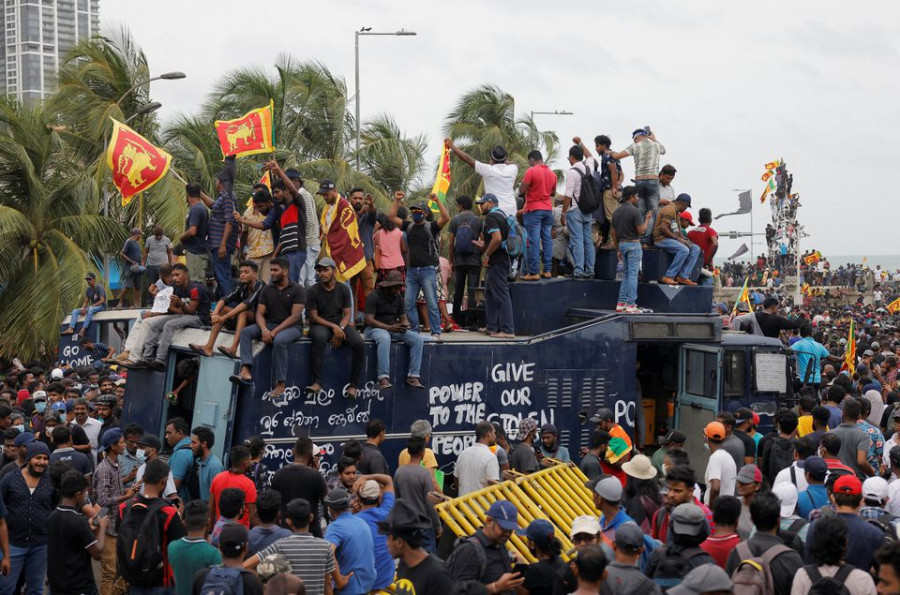Columns
Guideline for the remittance-dependent
To avoid the Sri Lankan debacle, countries may want to consider realistic measures.
Durga P Gautam
While Sri Lanka was marking its 74th Independence Day earlier this year, an intriguing piece of news caught the attention of the world. The then president Gotabaya Rajapaksa had appealed to Sri Lankans abroad to send money home to overcome the island’s worsening economic crisis. But the Sri Lankan diaspora rebuffed his call for remittance which soon fell to its lowest level in decades. The resulting economic fallout was all but certain to swallow his government.
According to the World Bank, remittances have been the most significant source of external financing for low- and middle-income countries since 2016. When a country’s share of remittance stands high relative to its GDP, this money holds greater significance for its current account balance. In Pakistan, Lebanon and Nepal, where exposure to macroeconomic shocks such as natural calamities, political conflicts and vagaries of tourism is very high, substantial foreign income augmentation from overseas workers becomes vitally important.
Money for something
During the devastating period of hyperinflation in Zimbabwe in 2008-09, more than 3 million people migrated overseas. The foreign currency remittance sent by these Zimbabwean migrants kept the country from going under. Afghans received similar protection through remitted funds after the Taliban’s lightning-fast takeover of the country in 2021 and during natural disasters. The strong ties between the Bangladeshi diaspora and their home country represent an innovative model for remittance-dependent economies. The money sent home by these expatriates is now the country’s second highest foreign currency earnings and second largest reserves in South Asia.
Apart from the direct effects, remittances have generated multiplier effects. Demand for goods and services has surged, the poverty rate has dropped significantly, manufacturing and entrepreneurial activities have flourished, and Bangladesh has emerged as one of the fastest growing economies in the world. Another example is Ghana, which has transformed itself into a more resilient, inclusive, digitalised and diversified economy. Indeed, remittances enable backward economies to escape the poverty trap and help more globalised economies, such as China and India, to thrive.
Unlike foreign aid which goes to the government, remittances go directly to the families who need them. Remittances are typically recurring flows and behave countercyclically; and both features help the recipients survive income shocks. This enables consumption smoothing, stabilises household finances, and creates a higher demand for goods and services. The money has also been used to invest in real estate, finance investment projects and start new businesses.
Unfortunately, countries are not naturally endowed with remittances. As with Sri Lanka, calls for remittances may be ignored by expat communities. This is particularly worrisome following the Covid-19 pandemic and global recession, as many countries have found themselves with declining exports, rising debts and depleting foreign reserves.
To avoid the Sri Lankan debacle, countries may want to consider realistic measures. The first step is to help people find jobs in foreign countries. Worker training should be targeted at the needs of high-income countries. Governments should strengthen bilateral diplomacy and provide embassy services to ease the hiring of their citizens. Strong inter-agency coordination enhances trust among migrants. Migrant concerns from departure to return must be addressed. No one should ever be treated with prejudice, stereotyped attitudes or discrimination.
Research has shown that the digitalisation of financial services has increased the transfer of money, expanded the size of the formal economy, and fostered financial inclusion. This will minimise traditional methods of sending money such as hawala or hundi and increase formal remittances. The nation’s monetary policy and exchange rate regime play a dominant role in determining the size of remittances. Misguided policies and overvalued exchange rates dry up remittances and deplete foreign reserves.
Long-term strategy
A long-term strategy for persistent remittance flows requires more significant efforts. A consistent expansion of the pool of highly skilled migrants is necessary. The education and health sectors must receive top policy priority. Technology and communication services should be integrated into society’s daily schedule. This was a significant step through which the Indian diaspora in the United States made a breakthrough in the world market for e-services, making India the largest remittance-recipient country in the world for years.
Ultimately, the question is not whether people migrate or resources flow. They always do. The real question is the size and direction of the flow. According to Paul Collier, a world-renowned economic development expert, most low- and middle-income countries are integrated into the global economy through capital flight rather than capital inflows. These countries are losing capital because of bad governance, poor policies and political instability. The only long-term solution is to combat corruption, conduct institutional reform and maintain political stability. This requires the creation of a good investment climate, development of inclusive institutions and diversification of trade and commerce. Gotabaya Rajapaksa could have explored many avenues to this end. But he missed that opportunity in favour of excessive nepotism and arrogance, driving the Pearl of the Indian Ocean to bankruptcy and crushing the hopes of so many.




 9.12°C Kathmandu
9.12°C Kathmandu















